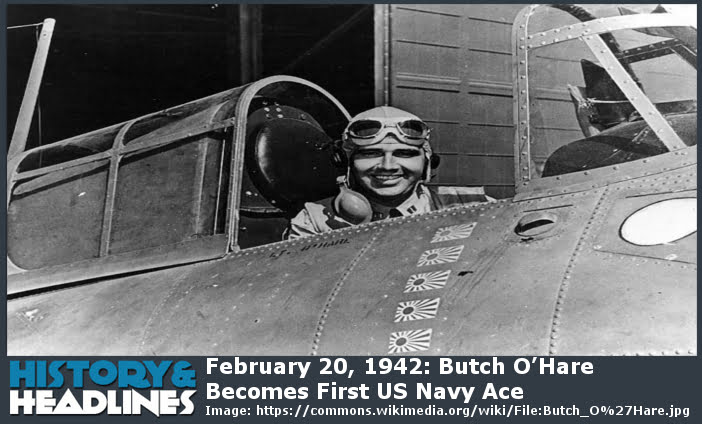A Brief History
On February 20, 1942, the United States was still reeling from the sneak attack at Pearl Harbor on December 7, 1941, and was in desperate need of victories after island after allied island fell to the seemingly unstoppable Japanese Navy and Army. Burma, Malaya, The Dutch East Indies, Solomon Islands, Gilbert Islands, Philippines, Wake Island, Singapore, Hong Kong, and numerous other places had fallen or been invaded by the Japanese. The US Navy that had been battered at Pearl Harbor was all that prevented Japan from sailing East to attack the US West Coast.
Digging Deeper
In this time of peril and non-stop bad news, Lt. Edward “Butch” O’Hare, USN, stood out as a beacon of hope for the Navy and the United States when he became the first US Naval Aviator to become an aerial “ace” by shooting down at least 5 enemy planes. The historic day was February 20, 1942, and O’Hare was flying from the USS Lexington, a valuable aircraft carrier and one of only a few the US had in the Pacific. The Lady Lex was under attack by various flights of Japanese aircraft, when from the opposite side from which the attacks had been coming another flight of Japanese bombers was spotted on radar, and closing fast. Only O’Hare and his wingman were available to counter this new threat, and the wingman had jammed guns!
O’Hare was left as the only hope of stopping the 8 “Betty” bombers from sinking his ship, and he attacked with skill and daring, managing to get credit for shooting down 5 (official) or 6 (sometimes reported) of the 8 bombers. O’Hare’s Grumman F4F-3 Wildcat only carried about 450 rounds of ammo for each of his 4 .50 caliber machine guns, enough for barely over a half minute of firing. Between shooting down bombers and attacking the remainder, no bombs landed on the Lexington, and O’Hare became an instant hero and celebrity for becoming the first US Navy ace and doing it in only 1 action. (Later analysis indicated he probably shot down 3 of the bombers.) O’Hare was estimated to have used only about 60 rounds apiece for the planes he shot down, remarkably accurate fire during aerial combat.
When O’Hare was landing after the action, one of the .50 caliber machine gunners on the Lexington took him under fire, but happily missed the Wildcat. O’Hare is said to have approached the embarrassed and mortified young sailor and said, “Son if you keep shooting at me when my wheels down I’m going to have to report you to the gunnery officer!”
O’Hare’s Wildcat had only suffered a single bullet hole from the action, but when that particular fighter was being transferred to the USS Yorktown, the new pilot failed to take off and plopped into the ocean, losing the plane (though the pilot lived). For his heroism Butch O’Hare became the first US Naval Aviator to earn the Medal of Honor.
After the obligatory stateside parades and speeches, O’Hare eventually returned to combat in the Pacific, this time flying the superb Grumman F6F Hellcat. Flying the new fighter, O’Hare managed to earn a pair of Distinguished Flying Cross medals. O’Hare was promoted to Lieutenant Commander and given command of the USS Enterprise air group, usually flying a torpedo bomber as a command aircraft. The fighter bug had O’Hare, and when he decided to take a Hellcat on a mission it would be a fatal choice. On November 26, 1943, O’Hare led a night intercept of Japanese bombers and was probably caught in a crossfire between a bomber and another US plane (Avenger torpedo bomber used as a radar plane to guide the US fighters). O’Hare’s Hellcat veered off into the darkness and was never seen again. The Navy hero was dead. O’Hare’s widow later received his posthumous Navy Cross and Purple Heart medals.
In 1945 the US Navy christened a new destroyer the USS O’Hare in Butch’s honor, and in 1949 the Chicago airport was renamed O’Hare Airport after the fallen hero.
Edward “Butch” O’Hare lived and died an American hero, but in a twist worthy of making you say “Wha wha wha whaaat?!” another part of the story is that Butch’s dad, “Easy” Eddie O’Hare was a criminal lawyer for Al Capone in the Chicago underworld, and later ratted out Capone to avoid going to jail himself!
Question for students (and subscribers): Have you ever wanted to be a flying ace? Please let us know in the comments section below this article.
If you liked this article and would like to receive notification of new articles, please feel welcome to subscribe to History and Headlines by liking us on Facebook and becoming one of our patrons!
Your readership is much appreciated!
Historical Evidence
For more information, please see…
Ewing, Steve and John B. Lundstrom. Fateful Rendezvous: The Life of Butch O’Hare. Naval Inst Pr, 1997.
The featured image in this article, a photograph of Lt. Butch O’Hare seated in the cockpit of his Grumman F4F “Wildcat” fighter, circa spring 1942, is a work of a sailor or employee of the U.S. Navy, taken or made as part of that person’s official duties. As a work of the U.S. federal government, it is in the public domain in the United States.


